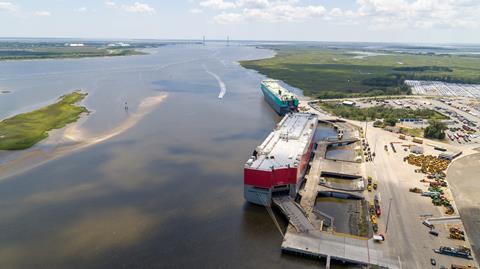US state legislature, the Georgia General Assembly, has allocated $6m for special harbour improvements at the port of Brunswick.
According to Georgia Ports Authority (GPA), the improvement plan, which has been recommended by the US Army Corps of Engineers, includes a bend widener, expansion of the turning basin, where ships are turned before docking at Colonel’s Island terminal, and an expanded meeting area at St Simons Sound.

“For the past four years, we’ve seen an increasing number of vessel calls at the port of Brunswick, and the car carriers serving Colonel’s Island have expanded in size to 7,000-vehicle capacity,” said GPA president and CEO Griff Lynch. “An improved channel will better accommodate growing business demand, and perfectly complements the terminal improvements we’re making in Brunswick.”
The Colonel’s Island terminal provides services for 23 carmakers and 17 heavy machinery makers. Last year the US port of Brunswick moved more than 775,560 finished vehicle and machinery units, an increase of 15.6% on ro-ro performance in 2022. In February this year carmaker Ineos said it had chosen the port of Brunswick to import its Grenadier off-road SUV for distribution to dealers in the south-east of the US. Ineos assembles the Grenadier in Hambach, France.
“We have selected the Port of Brunswick as our strategic gateway to the East Coast to cover customer volume along the major cities across the region,” said Gabriel Pernia, planning and logistics director at Ineos Automotive Americas. “Brunswick represents our tactical and geographical preferred location to cover our sales distribution network. The port provides an extensive capacity for vehicle storage, processing and maritime cargo which helps to minimise total transit time and improve customer order deliveries.”
GPA is investing more than $260m in infrastructure at Brunswick port. It recently added 32,500 sq.m of on-dock warehousing at the Colonel’s Island automotive terminal as well as 9,300 sq.m of warehousing on the south side of the island. It has also added 32 hectares for ro-ro storage.
There are also a couple of capacity projects currently under construction, including buildings totalling 16,900 sq.m and another 17 hectares of ro-ro cargo storage. The projects are aimed at increasing the terminal’s capacity for finished vehicle and machinery processing.
Look out for our review of activity at the North American vehicle-handling ports in the summer edition of Automotive Logistics magazine, which is due out in May this year


























![Global[1]](https://d3n5uof8vony13.cloudfront.net/Pictures/web/a/d/s/global1_726550.svgz)













No comments yet